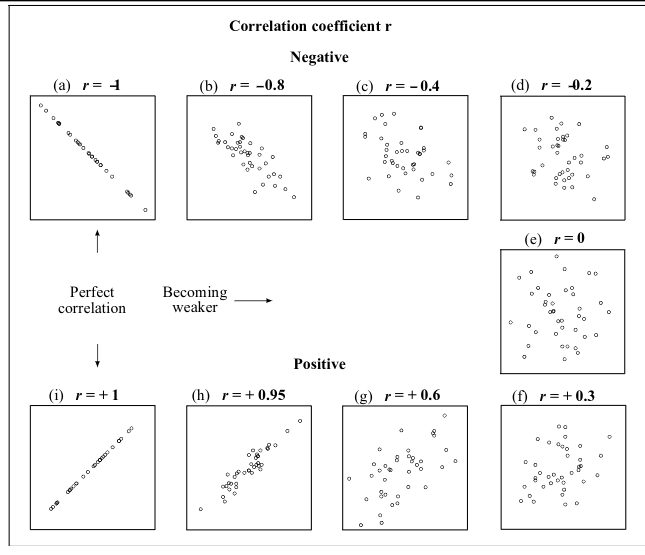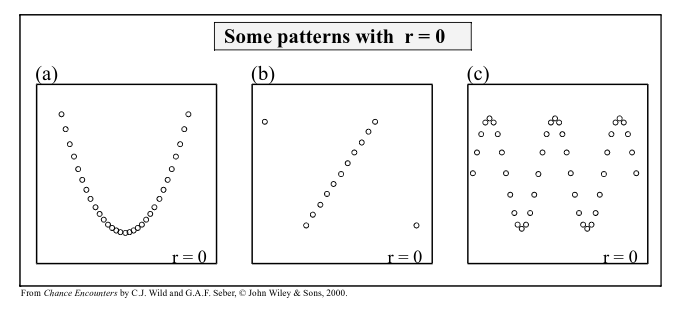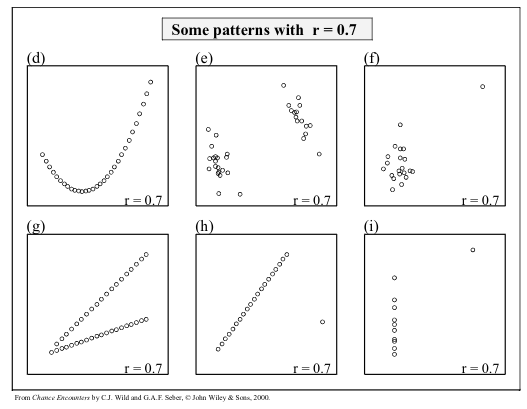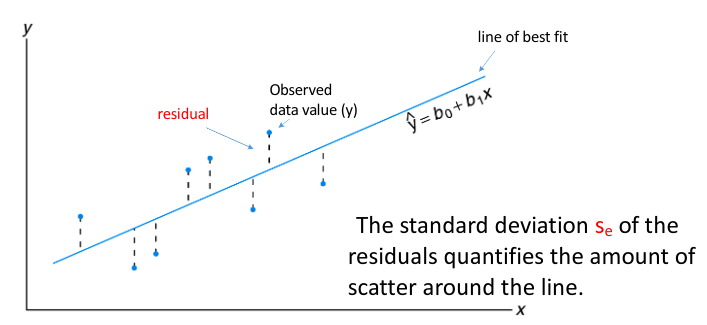6.4 KiB
6.4 KiB
- #ST2001 - Statistics in Data Science I
- Previous Topic: Hypothesis Testing
- Next Topic: No next topic.
- Relevant Slides:
-
Modelling Relationships
- In may applications, we want to know if there is a relationship between variables.
- What is Regression? #card
card-last-interval:: -1
card-repeats:: 1
card-ease-factor:: 2.5
card-next-schedule:: 2022-11-18T00:00:00.000Z
card-last-reviewed:: 2022-11-17T19:35:13.517Z
card-last-score:: 1
- Regression is a set of statistical methods for estimating the relationship between a response variable & one or more explanatory variables.
- Regression may have the aim of explanation (describing & quantifying relationships between variables) or prediction (how well can we predict a response variable from explanatory variables).
-
Correlation Coefficients
- What is the Sample Correlation Coefficient? #card
card-last-interval:: -1
card-repeats:: 1
card-ease-factor:: 2.5
card-next-schedule:: 2022-11-18T00:00:00.000Z
card-last-reviewed:: 2022-11-17T19:35:19.270Z
card-last-score:: 1
- The Sample Correlation Coefficient
rgives a numerical measurement of the strength of the linear relationship between the explanatory & response variables. -
r = \frac{\sum (x_i = \bar x)(y_i - \bar y)}{\sqrt{\sum (x_i - \bar x)^2 \sum (y_i - \bar y)^2}}
- The Sample Correlation Coefficient
- Note:
\rhois the population correlation coefficient, whileris the sample correlation coefficient. \rho = +1means a perfect, linear direct relationship betweenX&Y.\rho = 0means no linear relationship betweenX&Y.\rho = -1means a perfect, inverse linear relationship betweenX&Y.- Correlation treats
x&ysymmetrically - the correlation ofxwithyis the same as the correlation ofywithx. - Correlation has no units.
- Correlation is not affected by changes in the centre or scale of either variable.
- The correlation coefficient only measures linear association.
- The correlation coefficient can be misleading when outliers are present.
-
Correlation
\neqCausation- Correlation does not imply causation.
- Scatterplots & correlation coefficients never prove causation.
- A hidden variable that stands behind a relationship & determines it by simultaneously affecting the other two variables is called a lurking or confounding variable.
- Don't say "correlation" when you mean "association".
- More often than not, people say "correlation" when they mean "association".
- The word "correlation" should be reserved for measuring the strength & direction of the linear relationships between two quantitative variables.
- Correlation does not imply causation.
-
Summary
- Scatterplots are useful graphical tools for asserting direction, form, strength, & unusual features between two variables.
- Although not every relationship is linear, when the scatterplot is straight enough, the correlation coefficient is a useful numerical summary.
- The sign of the correlation tells us the direction of the association.
- The magnitude of the correlation tells us the strength of a linear association.
- Correlation has no units, so shifting or scaling the data, standardising, or swapping the variables has no effect on the numerical value.
- What is the Sample Correlation Coefficient? #card
card-last-interval:: -1
card-repeats:: 1
card-ease-factor:: 2.5
card-next-schedule:: 2022-11-18T00:00:00.000Z
card-last-reviewed:: 2022-11-17T19:35:19.270Z
card-last-score:: 1
-
Simple Linear Regression
- What is Simple Linear Regression? #card
card-last-interval:: -1
card-repeats:: 1
card-ease-factor:: 2.5
card-next-schedule:: 2022-11-18T00:00:00.000Z
card-last-reviewed:: 2022-11-17T19:34:38.355Z
card-last-score:: 1
- Simple Linear Regression is the name given to the statistical technique that is used to model the dependency of a response variable on a single explanatory variable.
- The word "simple" refers to the fact that a single explanatory variable is available.
- Simple Linear Regression is appropriate if the average value of the response variable is a linear function of the explanatory, i..e, the underlying dependency of the response on the explanatory appears linear.
- Simple Linear Regression is the name given to the statistical technique that is used to model the dependency of a response variable on a single explanatory variable.
-
Strategy
-
- Propose a model
- Check the assumptions.
- Make some predictions.
- The predicted value is often referred to as
\hat y.
-
- Assess how useful it is.
- Improve it.
-
-
Interpreting the Slope & Intercept #card
card-last-interval:: -1 card-repeats:: 1 card-ease-factor:: 2.5 card-next-schedule:: 2022-11-18T00:00:00.000Z card-last-reviewed:: 2022-11-17T19:34:57.106Z card-last-score:: 1b_1is the slope, which tells us how rapidly\hat ychanges with respect tox.- e.g., what is the change in the mean current per unit increase in wind speed.
b_0is the y-intercept, which tells us where the line intercepts the $y$-axis whenxis 0.- e.g., what is the mean current when the wind speed is 0.
-
The Residual Standard Deviation (
card-last-interval:: -1 card-repeats:: 1 card-ease-factor:: 2.5 card-next-schedule:: 2022-11-18T00:00:00.000Z card-last-reviewed:: 2022-11-17T19:35:04.870Z card-last-score:: 1s_e) #card- The standard deviation of the residuals
s_e(also known as the residual standard error) measures how much the points spread around the regression line. - You can interpret
s_ein the context of the data set -it is the typical error in the predictions made by the regression line.
- The standard deviation of the residuals
- The line of best fit is the line for which the sum of the squared residuals is the smallest, the least squares line.
-
Simple Linear Regression Model
-
Y_i = \beta_0 + \beta_1 x_i + \epsilon_i \text{ for } i =1, \cdots, n \text{ assuming } \epsilon_i \sim N(0, \sigma_e) -
Features of this Model
- $\beta_o£ (intercept) and
\beta_1(slope) are the population parameters of the model & must be estimated from the data asb_0(sample intercept) andb_1(sample slope).
- $\beta_o£ (intercept) and
-
- What is Simple Linear Regression? #card
card-last-interval:: -1
card-repeats:: 1
card-ease-factor:: 2.5
card-next-schedule:: 2022-11-18T00:00:00.000Z
card-last-reviewed:: 2022-11-17T19:34:38.355Z
card-last-score:: 1
_1668682885675_0.pdf)



